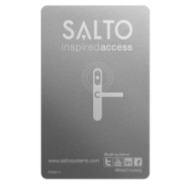Introduction to keys in Space
About keys
In Salto Space, a key controls access to an area, building, and/or installation asset (for example, a cupboard or locker), as well as who and when can access there. The Keys section describes the various types of keys that can be used with Space. It also describes how to assign, read, delete, update, and cancel user keys. Broadly speaking, there are two types of keys in Space: physical and digital.
- Physical keys refer to physical user credentials such as keycards, wristbands or fobs. They are encoded with the access data (who can enter where and when). That is why the technology is called Salto data-on-card. For example, all staff can be given access to a company's main building entrance but access to certain internal areas can be restricted to specific members of staff and to specific times.
You must install the Local IO Bridge when assigning, reading, deleting, and updating physical keys with an encoder that is connected by USB.
- Digital keys represent a digital credential you need to present at electronic locks to gain access. Digital keys in Space can be materialized in the JustIN Mobile app. The JustIN Mobile app is available on Android and iOS platforms, and allows users to use their smartphone as a key.
About key configuration
You must perform certain configuration tasks for keys from the tabs in System > General options.
You can use the Users tab to:
- Enable or amend options for user keys
- Configure tracks content
- Configure Wiegand codes
See Users tab for more information.
You can use the Hotel tab to do the following:
- Enable or amend options for guest keys
- Configure tracks content
- Configure the Wiegand code
See Hotel tab for more information.
You can use the Visitors tab to do the following:
- Enable options for visitor keys
- Amend options for visitor keys
You can also select particular key configuration settings on the Access points and Users tabs. See Access points tab and Users tab for more information.
Types of physical keys
Physical keys are available in a wide range of formats, such as keycards, wristbands, stickers or fobs.
| Examples of physical keys | |
|---|---|
| Keycard |  |
| Wristband |  |
| Sticker |  |
| Fob |  |
See the Salto corporate site for more information on physical key types.
Key status icons
Different icons are displayed in the Key status column on the Users screen when keys have been assigned to users. These icons vary depending on the status of keys. The key status is also shown on the User information screen. See Assigning keys for more information about assigning keys to users.
The icons are described in the following table.
| Icon | Description |
|---|---|
 No update required | Indicates that a key has been assigned to a user and no updates are required. Updates may be required if a user's access permissions have changed, for example. |
 Key expired | Indicates that a user's key has expired. This icon is displayed when the expiration date of a user's data and access permissions has passed. In this case, the user must update their key by presenting it to an SVN updater point, like a wall reader or an encoder. See User and key expiration for more information. |
 Re-edition required | Indicates that a user's key needs to be re-edited using an encoder. This icon is displayed if you make changes that affect the structure of the key. Such changes include system edits or amendments to the user's profile. Note that the lights displayed by SVN wall readers indicate whether keys need to be re-edited. For example, when you present iButtons and proximity cards to an SVN wall reader, a flashing blue light is displayed when they are being updated, and a green or red light is displayed when the door is opened or closed respectively. If the light changes to a solid blue light, the key needs to be re-edited. For smart cards, a solid orange light is displayed to indicate that they need to be re-edited. |
 Update required | Indicates that a user's key needs to be updated at an SVN updater point, such as a wall reader or encoder. This icon is displayed if you make changes to a user's data. It is also shown if a user's key is due to expire within a period of 7 to 15 days and needs to be revalidated. This depends on when the key was edited. If the key was edited between 7 to 15 days ago, the system recommends an update 7 days before its expiration date. If it was edited more than 15 days ago, the system recommends an update 15 days before the expiration date. Note that if you encode keys for a period of less than 7 days, the icon is not displayed. |
 Pending activation | Indicates that the key has been assigned to the user at the database level but it still hasn't been delivered to the corresponding JustIN Mobile app. This could be either due to an incorrect phone number being used or the user not having the app installed yet. Note that this feature is only for digital keys and only applies when assignment of digital keys is done through DBSync. |
